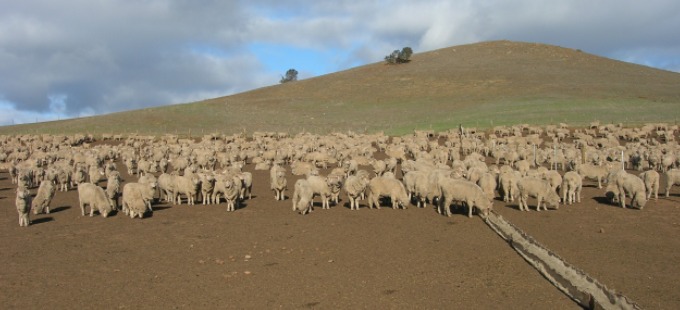
Sheep and lambs in a confinement area.
SOUTHERN Western Australian wheatbelt and south coastal sheep producers are being advised to consider confinement feeding over summer to protect their paddocks from wind erosion.
Department of Primary Industries and Regional Development veterinary officer Danny Roberts said confined paddock feeding was a good option when the dry matter in paddocks had declined to less than 750 kilograms per hectare, or 50 per cent groundcover.
“Successful confinement feeding relies on good site selection, an appropriate mob size and stocking density, and the provision of adequate energy, protein, roughage and water.
“A guaranteed supply of good quality water is essential and should preferably be supplied through troughs, not dams,” Dr Roberts said.
Dr Robert said non-pregnant sheep were easier to introduce to a confinement area, particularly for producers who had not had much experience in confinement feeding.
“The introduction to a new ration needs to occur over a minimum of two weeks when fed barley, wheat, triticale, vetches, faba beans or peas or any combination of these diets high in starch.
“Use of lupins and pellets can be a better option if confinement feeding sheep for the first time,” he said.
“Non-pregnant adult sheep need to be fed for maintenance of liveweight, while weaned lambs need feeding for growth of one kilogram or more per month.”
“All sheep need to receive two clostridial vaccinations before the start of confinement feeding.”
Dr Roberts said it was important to remember that any sudden change in the diet may cause digestive problems so it was important to plan ahead with feed types and quantities.
“Monitoring the liveweight or condition score of sheep in a confined area every four weeks is important as feeding may need adjustment based on condition score,” he said.
Dr Roberts said when managing mated ewes with poor paddock feed, introductory feeding should start no later than 70 days after the introduction of the rams.
“Late pregnant ewes should still lamb in a paddock rather than in confinement pen or small paddock,” he said.
More information on successful confinement feeding and feed budgeting is available on the department’s website.
Source: DPIRD.

HAVE YOUR SAY